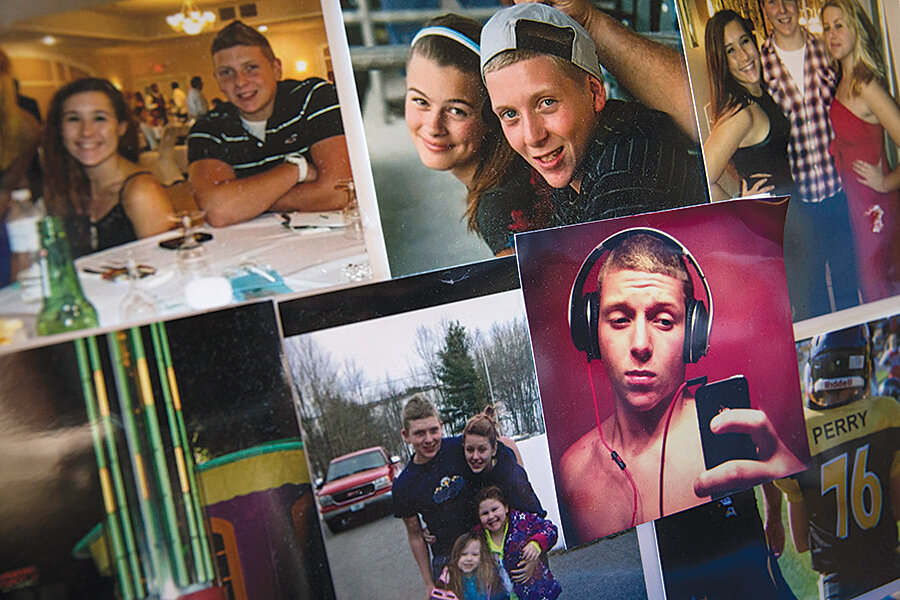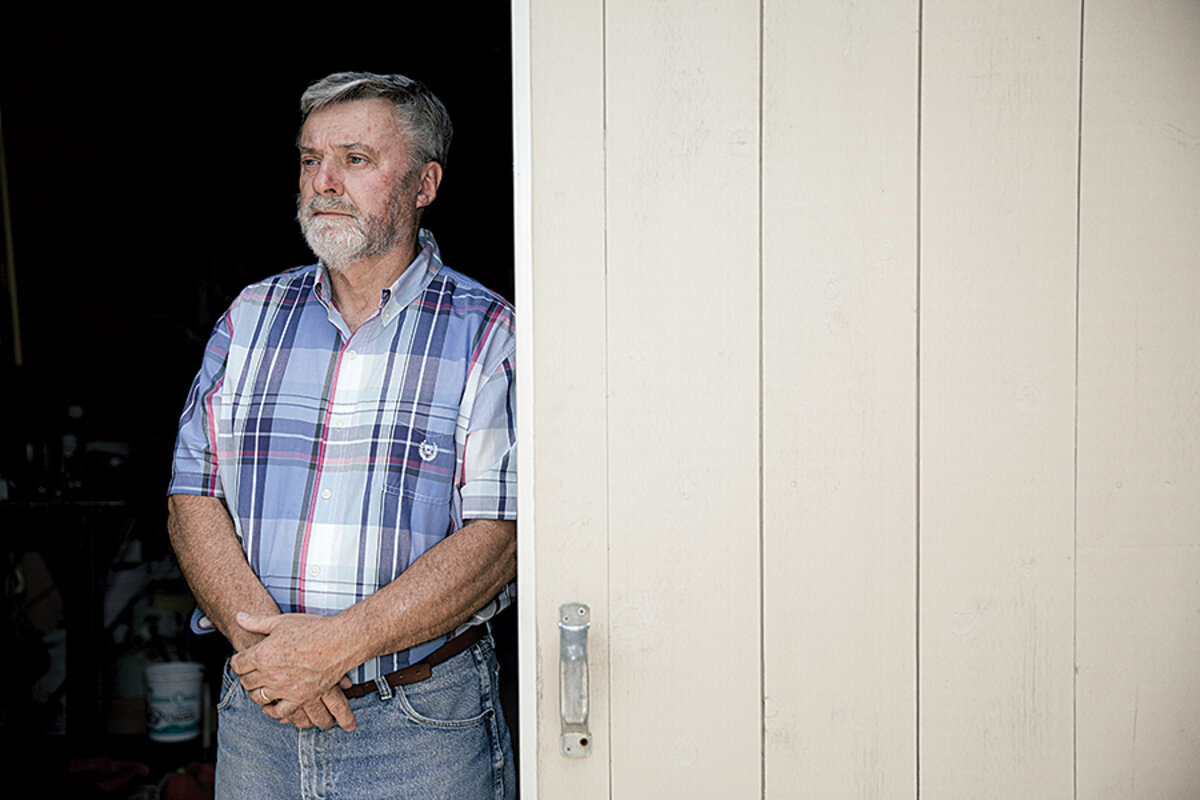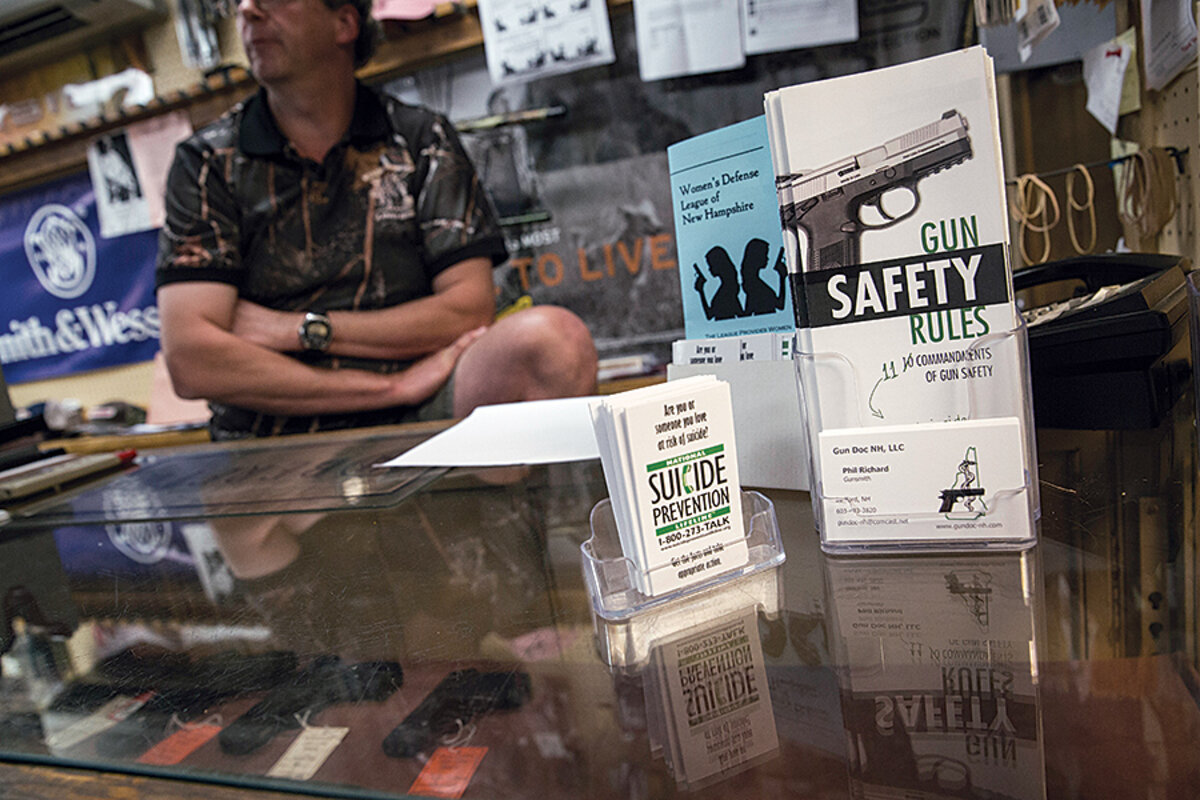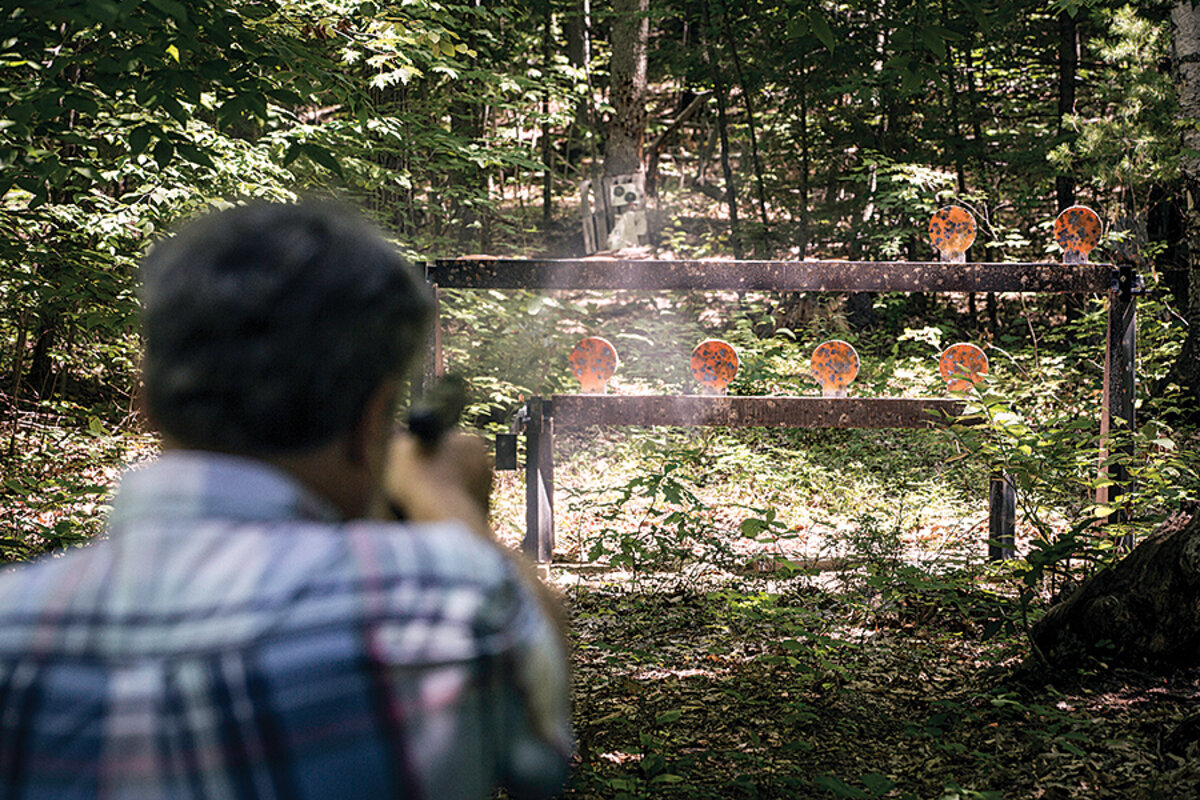An unusual alliance to curb gun suicides
Loading...
| Hooksett, N.H.
As the longtime owner of a gun store, Ralph Demicco is passionate about his firearms. At the modest ranch house he built himself outside this rural New Hampshire town, he keeps a collection of rifles, shotguns, pistols, and antique weaponry, including two cast-iron cannons that he stores in the barn beneath an oval wooden wall plaque inscribed with the Second Amendment.
On special occasions, he wheels out his beloved cannons – replicas of Dutch and British models – and fires off thunderous shots that reverberate through the New England woods the way they might have in the Revolutionary War 240 years ago. Mr. Demicco, a barrel-chested man with a sweep of graying hair, maintains a 200-yard firing range at the back of his property where he practices his marksmanship. His three sons learned to shoot here. One son later followed him into the gun business.
Despite his love of all things with bullets and buckshot, however, Demicco is also part of a quiet movement sweeping the United States that makes him anathema to many of his gun-owning brethren: He is working with mental-health experts and community groups on a campaign to reduce suicides by firearms.
His group, the New Hampshire Firearm Safety Coalition, asks gun sellers and firing ranges to watch out for any buyers who might be at risk. It promotes the safe storage of guns at home. Its members look out for fellow gun enthusiasts in emotional crises, and encourage them to ask friends to babysit their firearms if they seem to have suicidal thoughts.
All this may seem relatively innocuous – even common sense – in a nation in which, every week, 400 people use a gun to take their lives. But it isn’t. In an age of hyper-partisanship over gun policy, many gun enthusiasts loathe mental-health professionals, who are often outspoken about the need for more controls on firearms and feel mutual antipathy toward gun owners.
The coalition here has found common ground by echoing the “harm reduction” strategy used to combat drug use, which prioritizes clean needles and health screenings over law enforcement and mandatory treatment. It sidesteps the standard response of many health officials to gun violence, which is to see the weapon as the problem and the culture of gun owners as an obstacle. It assumes that the vast number of guns in private hands – one for every man, woman, and child in the US – will remain there.
In other words, the US is not Australia or Britain. To take a bite out of suicide requires working with gun-rights advocates in a way that doesn’t cause them to reflexively tune out their opponents.
“If you want to reach gun owners, it doesn’t make sense to go at them with an antigun agenda,” says Catherine Barber, a researcher on suicide prevention at the Harvard T.H. Chan School of Public Health. “It makes more sense to work within the culture of gun-owning groups.”
In the gun community it’s axiomatic that people, not guns, kill people, since the responsibility lies with the person pulling the trigger. To gun control groups, the slogan is reversed: It’s guns that kill people by means of their lethal capability. When it comes to suicide, the answer may contain elements of both.
“Everybody agrees that suicide is harmful to the individual and the family, and you can’t say ‘no’ to that,” says Demicco. “It’s obvious. Everyone agrees that if someone is under stress you don’t want to be selling them a gun.”
The project in New Hampshire has now been adopted in various forms in 20 states. Experts believe the initiative will save lives – and is already helping to build mutual respect across one of the most intractable divides in American society.
The effort here in the New England woods started as many such movements often do – with a string of tragedies. In May 2009,
Demicco got a call from Elaine Frank, director of the Injury Prevention Center at Children’s Hospital at Dartmouth-Hitchcock Medical Center in Lebanon, N.H. Demicco had worked with Ms. Frank in the 1990s on a statewide campaign on firearm safety and knew her to be a pragmatic coalition builder who left politics at the door.
“In my mind, when someone from the health-care community considers a firearms issue, I’m always somewhat skeptical,”
Demicco says. But when Frank talked to him about how to reduce gun accidents involving minors, Demicco didn’t hear a broadside against irresponsible gun owners. He heard a tone of respect.
Massad Ayoob, a firearms instructor and handgun expert whom Frank also recruited to the campaign, says she bridged the gap between the gun community and the public-health world. “She is the only person I’ve ever seen bring the two factions together as common cause. She really did the impossible,” he says.
Frank, who wears wire-rimmed glasses and speaks in the cadence of a schoolteacher, says she came at the issue from a safety perspective. “This isn’t about whether anyone thinks guns are good or guns are bad,” she says.
Her call to Demicco in 2009 was about Riley’s Sports Shop, the gun dealership he owned. She told him that three people who had committed suicide during a single week the previous month had used guns purchased just hours before from Riley’s.
Demicco pulled the paperwork on the victims. All three had shown a familiarity with firearms, according to the clerks who had served them. All had passed background checks. All were now dead.
Demicco was horrified, says Frank. She invited members of the firearm-safety coalition to meet again and see what could be done. Ideas were tossed around, but nothing jelled until Ms. Barber, the Harvard academic, proposed going to gun shops with an anti-suicide message.
To reach those at risk, the coalition would be relying on the credibility of gun dealers to give practical advice and keep an eye on buyers. And it would have to face the inevitable prickliness of gun sellers toward do-gooders trying to tell them how to run their businesses. Gun-rights advocates often view such cooperative efforts as nothing more than a disguised grab for their firearms.
Yet the coalition had good reason to want to do something. Nearly two-thirds of all firearm deaths in the US are suicides. As the overall rate of homicides in the country keeps falling, suicides continue to climb: Between 1999 and 2014, the suicide rate rose by 24 percent, according to the Centers for Disease Control and Prevention. Among men, who are nearly four times as likely as women to take their own lives, more than half used a gun to kill themselves. In 1999, the number of firearm suicides was 16,599. By 2014, it had risen to 21,334, out of a total of 42,773 suicides.
More people attempt suicide by swallowing pills rather than by shooting themselves. But unlike attempts by firearms, overdose attempts are rarely fatal.
“What we’ve learned is that it does make a difference what method you reach for in a suicide attempt, [it affects] whether you live or die,” says Barber.
• • •
In 2010, the New Hampshire coalition drew up a list of 65 stores and began to canvass dealers for their views on suicide prevention and the role that firearms play. They showed them sample posters with anti-suicide messages. Some were receptive. Others weren’t. “They didn’t see suicide prevention as their role,” says Frank of the skeptics.
When Evan Nappen, a prominent pro-gun attorney in Concord, N.H., found out about the project, he wrote to gun stores urging them not to participate in what he called a sneaky campaign by antigun activists that could make dealers liable in the event of a suicide. He accused public-health officials of co-opting “well-
intentioned folks” like Demicco.
Frank laughs at the idea that she had strong-armed Demicco into such a campaign. “He’s not an easily duped guy. And I ain’t that powerful a person,” she says.
As Mr. Nappen stepped up his criticism, he began to get the attention of national gun-rights activists, which worried Demicco. He knew how quickly gun controversies could flare up, and he wasn’t sure how to douse the flames.
When he was vice president of the Gun Owners of New Hampshire, Demicco had worked closely with the National Rifle Association (NRA) and served on its public-policy committees, but his contacts had all left. And the National Shooting Sports Foundation (NSSF), the gun industry’s trade association, “didn’t want to talk to us. They thought it was too controversial,” he says.
NRA officials have tried to frame suicide as an issue that is separate from gun policy. The group accuses gun control advocates of using suicide to make the case for stricter laws because falling homicide rates have undermined the critics’ argument that more guns mean more violent crime.
Spokesman Lars Dalseide said the NRA was proud to support a voluntary program in Washington State that works with pharmacists and gun dealers on suicide prevention. But he blamed Congress for inaction on mental illness, which the NRA has repeatedly highlighted in its response to mass shootings.
“Suicide is a mental health issue and the failure of politicians to fix America’s broken mental health system has resulted in an epidemic of drug overdoses and an increase in suicides,” he said in a statement.
In August 2011, Demicco’s group began distributing posters and pamphlets to gun shops and ranges in New Hampshire. This time its efforts got attention from firearms advocates who saw it as a workable solution, not a flashpoint. In Maryland, Regina Schneider, whose husband owns two stores and heads the state’s gun dealers association, heard about the campaign from contacts at a national mental-health charity where she volunteers. She called Demicco to find out more and began working on a similar effort, as did gun dealers in Tennessee and Nevada. “It went viral,” says Demicco.
Utah makes it easy to buy, sell, and carry firearms. And Clark Aposhian, as head of the Utah Shooting Sports Council, the largest gun-rights group in the state, has helped to keep it that way.
In 2013, Steve Eliason, a Republican state lawmaker, looked at Utah’s data on youth suicides and at Barber’s Means Matter website at the Harvard School of Public Health, and realized that he needed Mr. Aposhian’s help.
Nationally, suicide is the second most common cause of death for teenagers. In Utah, it is the first. An average of four people ages 10 to 24 are treated every day in the state for suicide attempts, and of those who die, the majority use firearms. Utah is among several Western states with high gun ownership where suicide rates have risen steadily since the late 1990s.
In October 2013, Mr. Eliason called Aposhian, whom he knew as a lobbyist and a voter in his district. The two men met at a steakhouse in Salt Lake City and Eliason tactfully made the case that Utah had a gun-suicide problem.
Aposhian said he was shocked by the impact of suicide on gun owners, his constituents. He had spent years sparring with gun control groups over the facts of gun violence, but “nobody on either side told us what role suicide played in it.”
“I think when Clark saw the data, he jumped on board,” says Eliason. “Gun owners are not necessarily any more likely to attempt suicide than non-firearm-owners. It’s just that the method that they chose is far more fatal than other methods.”
Eliason introduced him to Barber and to her work in New Hampshire, and they began talking about a campaign that could help at-risk gun owners in Utah. It would become a statewide collaboration that overcame the gulf between gun lobbyists and health officials and won bipartisan backing from lawmakers.
Eliason began drafting a bill on suicide prevention, including pamphlets that would go to safety instructors, school districts, and health-care professionals. When the NRA found out, it criticized the move. So Aposhian stepped in, and invited an NRA official to vet the materials and to meet with Barber’s team.
One draft pamphlet advised families that, if someone may be suicidal, they should remove all guns and limit the amount of medications in the house. That double standard – zero guns, fewer pills – was a no-no, says Aposhian. “When the gun owner reads that, they’re going to stop reading right there,” he says. Barber’s team agreed to reword the advice to securing the firearms, not removing them.
Aposhian says that this spirit of give and take helped to build confidence after decades of what he calls “deception on both sides” of gun politics. For his part, he says gun owners must stop disputing that firearms are used in many suicides. “We’ve accepted this. We’ve owned this,” he says.
While the relationship between gun ownership and gun violence is hotly disputed, academics have found a strong causal connection for suicide. The evidence “is really overwhelming,” says Matthew Miller, an epidemiologist and co-director of Harvard’s Injury Prevention Center.
One study of the gun controls that went into effect after the Brady Handgun Violence Prevention Act was passed in 1993 found a drop in suicides among people over the age of 55 but no effect on homicides. Another study of all handgun buyers in California in 1991 found that suicide was the leading cause of death in the first year after the purchase. “When people smoke, they’re more likely to develop lung cancer. When people have guns around, they’re more likely to die by suicide,” says Dr. Miller.
Eliason’s bill passed in 2014 with bipartisan support. In addition to raising suicide awareness, it funded the distribution of tens of thousands of free trigger locks in Utah and rebates on new gun safes, to encourage more secure storage of firearms.
Aposhian continues to work with Barber. He recently taped a safety video for gun instructors to use in concealed-carry classes. Utah is one of only two states to mandate suicide-prevention education in firearms training.
“Gun-owning families can bring down the number of firearm-
related suicides, and we can do it without government mandates,” Aposhian says in the video. “Together we can protect our families, our friends, and our freedoms.”
In New Hampshire, the coalition’s anti-suicide messages are finding their way into gun shops. Researchers surveyed gun stores six months after the initial mailing and found nearly half were displaying the coalition’s materials, a response that Barber says is exceptional for a voluntary campaign.
One participant is John Yule, who manages a small fishing and hunting store in Manchester. Inside, on a glass display case of handguns, rests a box of cards with advice on suicide prevention and pamphlets of the 11 Commandments on Gun Safety, the 11th being to consider off-site storage of firearms when a family member is suicidal. Mr. Yule says customers take the materials, whether for themselves or others, and he’s never heard a negative reaction.
But there are also naysayers, including at Riley’s, which Demicco sold in 2014 after 40 years in the business. On a recent visit to the store, a windowless bunker on a state highway, no suicide-prevention materials were visible inside. When asked about the campaign, a store manager said curtly that Demicco was no longer the owner.
Demicco believes he did help avert suicides when he ran the shop. He refused to sell to buyers in distress, including a woman in a business suit who confessed that she had been discharged from a psychiatric facility and intended to kill herself. On another occasion, Demicco received a letter of thanks from an attorney for saving his client’s life by allowing her to return a firearm, no questions asked. “It’s a good feeling, and it doesn’t take much,” he says, his eyes softening. (Both cases predated his campaign.)
Experts say suicide is often impulsive: One study of survivors found that the majority had thought about the act for an hour or less, and
1 in 4 for just five minutes. There’s nothing inevitable about suicide, which is why many experts believe that curbing access to lethal means, from pills to guns, saves lives.
Last September Joshua Perry, a high school student in Salem, N.H., was found dead in an abandoned building. At his side lay a Smith & Wesson .357-caliber handgun that belonged to Gary Boutin, his great-uncle and guardian. At the family’s cluttered house, Mr. Boutin keeps a bulletin board of faded snapshots: Joshua tossing a football, visiting Washington, D.C., standing on a snowy street with his three sisters.
Joshua was popular and played running back on the high school football team. He also loved to dance and make jokes, says Kathy Stimson, his grandmother. But childhood trauma, including the suicide of his mother when he was 10, cast a long shadow. “He was hurting so much inside. He wanted to make everyone else feel good,” she says.
Boutin, a house remodeler, says he taught Joshua to shoot, starting with a pellet gun at age 7, then moving on to shotguns and pistols. He kept the .357-caliber handgun unloaded in a downstairs clothes closet next to a wooden table that, today, is strewn with Barbie dolls and children’s books. Boutin says he realized his gun was missing on the night that Joshua didn’t come home from school. Police found his body the next day.
Boutin says at first he felt responsible for the youth’s death, but now he sees the gun as a tool, not the cause of the tragedy. “If it wasn’t the gun, he would have got his hands on pills or something else,” he says. “It wasn’t the result of what he used.”
For Ms. Stimson, knowing about her grandson’s psychiatric distress doesn’t stop her from blaming the firearm that took his life. “If it wasn’t so easy, it would never have happened – if it had had a lock on it, or there was just no gun in the house,” she says.
• • •
As Joshua’s death shows, most firearm suicides don’t require a trip to the gun store: Fewer than 1 in 10 in New Hampshire is traced to newly purchased guns. Tracking these cases is one way, however, to assess the coalition’s work.
In the first two years after the gun shop project launched, suicides using new guns fell sharply, only to rise again in 2014 and 2015. All told, the number of firearm suicides last year in New Hampshire was the same as in the year the project began. Barber says this is frustrating but speaks to the modest steps taken so far.
“As more gun-owner groups start taking on this message and saying part of firearm safety is keeping guns from suicidal family members, I think that’s when we might be able to detect a difference. We’re still at the very early stages,” she says.
Demicco believes the coalition is having an effect, too – “absolutely yes,” he says.
The project has moved from the margins of gun policy to the mainstream: The NSSF, the firearm-industry association, is now planning its own anti-suicide strategy to launch later this year. Spokesman Bill Brassard Jr. says it will be an education campaign for retailers, ranges, and gun owners.
Frank compares the coalition’s campaign to the decades-long effort to make drunken driving unacceptable, with social peers reinforcing the message. What was once taken for granted – someone driving home while inebriated – eventually became taboo, but it took many years. “The gun shop project isn’t the answer to this issue. It’s just one step,” she says.
For public-health advocates like Frank and Barber, it’s also a step toward finding common cause with the gun community. Neither is a gun owner. But last year both women decided to take a class together with Thomas Brown, a coalition member and firearms instructor who had invited them to shoot at a range in Manchester.
Frank says the class didn’t turn her into a gun enthusiast. But it put her in the shoes of those whose trust she wants to earn and whose pragmatism she needs to move forward. “While we continue in this country to yell at each other from both ends of the continuum, there are things we can be doing in the middle ground,” she says.









